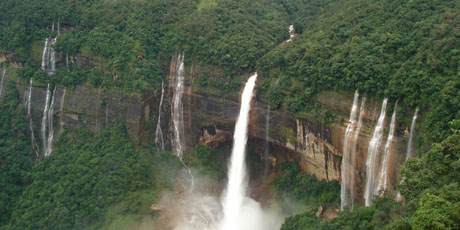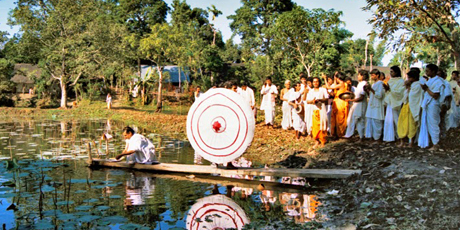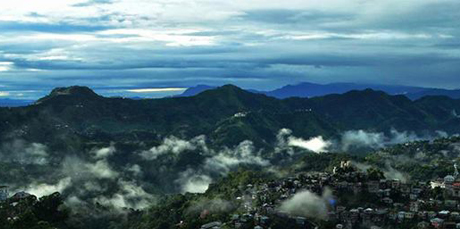I wish to highlight you a very interesting article found in the Tripura’s Maharajah’s newspaper “TNT: The North-East Today”. Here the original link: Myths & Legends from the Seven Sister states
Myths, Legends and Folklore have always been passed down from one generation to another. Grandparents have always been your storytellers on these fascinating and interesting stories over the past. What’s more interesting is that these different folktales bear the characteristics of the culture, folklore and customs of the people from which they originated. It’s a once upon a time story, but the legacy continues:
The Legend behind Nohkalikai Falls :Meghalaya
Welcome to Meghalaya “the abode of clouds” land of natural and enchanting beauties. For some travelers who may have visited the Nohkalikai falls it’s one of the famous tourist destination in the state. In fact, it is the most brilliant and tallest plunge waterfall in India. At 335 meters it is the highest plunge waterfall in India. Just a 10 minutes drive from main town of Cherrapunji, credited as being the wettest place on Earth. But if one thing that you’ve been missing about this place is the heart-rendering story behind falls.
The Nohkalikai Falls got its named after a tragic death of a Khasi woman. According to the legend, in a village Rangjyrteh upstream from Nohkalikai Falls, a woman by the name Likai resided there and was to married to a new husband after her husband died. Ka Likai (‘Ka’ is the prefix given for the female gender in Khasi) was left with her infant girl with no means of income and with no options left, she had to become a porter herself in order to earn her daily bread and butter to feed her only daughter. Her new husband, was selfish and brutal. He was jealous of his step-daughter because his wife paid her more attention. When he found out that Ka Likai had married him so that it would be easier for her to take care of the child, he was determined to harm her. He refused to go out to work, but forced his wife to go everyday. When she was not at home he bullied and ill-treated the child. One day Ka Likai had to go on a long journey. This gave the step-father an opportunity and he killed his step-daughter. When Ka Likai returned, she was surprised to find her husband in a better mood. She noticed the child’s absence and asked about her. But the husband answered that she was playing and dispelled the mother’s misgivings. She sat down to eat without any suspicion of evil doing. After Ka Likai had her supper, she took out the betel-nut basket to prepare betel to chew after the meal, as was the custom of the land. It so happened that the murdered child had been left in this basket which the mother saw. She wildly demanded to know the meaning of this awful discovery, whereupon the husband confessed his crime. The terrible and overwhelming revelation came as an immense shock to the mother. She was stunned with grief and disbelief. She rose from the seat, ran to the edge of the precipice and threw herself into the abyss. Her fall caused a waterfall famously known as the Nohkalikai Falls, or “The Leap of Ka Likai” in the local language. The moans of the Falls are said to be the echoes of Ka Likai’s never-ending anguished cries that one can hear even today.
The Myth of Mayong ‘Land of Black Magic’: Assam
Assam’s ancient rulers, they are known for the interesting myths and legends. But more than a rulers or any other folkore, what’s more interesting is the place, Mayong, located around 40km from the capital city Guwahati, the gateway to north-east, Mayong the very name itself holds a history and ever- unsolved mystery. Mayong – the name is believed to have originated from the word maya (illusion). The place is famed and feared as a land where “sorcerers and magicians” have held sway for centuries and the the legacy lives on. It was also said about the Mayong that the saints of black magic and the witches take shelter in mayong forest till now. Many tales of men disappearing into thin air, people being converted into animals, or beasts being magically tamed, have been associated with Mayong.
The Origin of Manipur: legend has it all
Manipur is the land of rich valleys surrounded by beautiful hills and lakes, a land of gentle people full of laughter and joy. Manipur means the ‘land of gems’. This northeastern state was described as the land of gold or ‘Suvarnabhu’.
More than a folk story many legends tell us the origin of Manipur. One of the legends is that Krishna requested Shiva to keep a watch while he danced the Ras with Radha and Gopis. Parvati on seeing Shiva protecting a particular spot was curious to see what Shiva was protecting. On her insistence, Shiva permitted her to see the Ras. She was so enamored by Krishna’s dance that she decided to perform the Ras with Shiva. Shiva searched for high and low for a beautiful and secluded place for dancing the Ras with Parvati. He saw Manipur surrounded by mountains and its beautiful valleys covered by a sheet of water. With his trident, he stuck the mountain ranges making a path for the water to flow out. The valley of Manipur emerged and Shiva and Parvati danced on it.
The Chhinlung rock and the legendary rain: Mizoram
Mizoram ,the land of the Blue Mountains. Evergreen ranges of Mizoram hills boasts of blooming exotic flora and dense bamboo jungles. Gushing rivers and sparkling waterfalls criss-cross these hills and its plunging gorges. The Phawngpui or ‘The Blue Mountain’ is one of the highest peaks.
Once upon a time, a heavenly creature swallowed the moon and the whole earth was plunged into darkness. Chaos reigned. Goddess Khuazingnu was worried about the future of creation. To protect them, she put a couple from each human clan and representatives of each species of animals into a pit and sealed it with a huge rock called the Chhinlung.
Some generations later, the goddess opened the mouth of the pit. Droves of humans emerged and she closed the Chhinlung for she reasoned there were enough people on earth. Among the people who emerged was a powerful man named Thlanrawkpa. He was named king and to celebrate he planned to host a feast, later to be known as the Thlanrawkpa Khuangchawi.
He, however, forgot to invite his father-in-law, Sabereka, who was furious and caused thunderstorms that washed away all the earth of the village, leaving behind only rock. The legendary rain is said to be the reason behind why a traditional Mizo house is built on stilts, to avoid such calamities.
Yeti, the giant abominable snowman: Arunachal Pradesh
In the land of the rising sun, Arunachal Pradesh tucked in the northeastern corner of the country. Besides the rich cultural legacy , Arunachal also has some interesting oral tradition of myths & legends. One such legend is of the Himalayan Yeti, the giant abominable snowman. Commonly known as Grep-fut, the Arunachalis have attributed the Yeti with a human face, a long nose, glittering eyes and a conical forehead. It supposedly has short yellowish-brown hair all over the body, but the hair on its head stands erect; it can run with tremendous speed from hill to hill and has a shrill cry. According to the tribal elders, the Yeti lives in a cave and eats kernels, usually of the Rachi and Ningohi trees. And it occasionally feasts on a human when it has managed to capture one. The female Yeti is believed to be distinctly different from the male, that its presence is supposedly marked by a strong odour, much like that of onion or garlic. That’s it for the Yeti but there is another fascinating tale about the reason for earthquakes. As the ‘Old Wives’ tale goes, the earth rests on a giant fish or on the horns of the ox. When the fish or the ox moves, the earth trembles!
The legend behind Earth, children and the moon: Nagaland
Once upon a time when the earth was still young, the Aos say that the moon lived very close to the earth. It even used to be a playmate to the children. Very often it stayed within reach, near the eaves of the roofs and watched the people of the village go about various activities. When the women husked paddy, the long poles used for this purpose would accidentally hit the moon and when it cried out in pain, the women would burst out laughing as though it was a big joke. Even the children, taking the cue from the women, began pelting the moon with pebbles, ash from the hearth and even cow dung. And when the moon cried out in pain and tried to cover its face, the children found it very amusing and this became their favourite pastime. When such infliction went on for some time and appeared to become regular, the moon decided to leave the earth and go far away from it where it would be safe from such cruel treatment. That is why; the Aos claim, the moon is so far away from the earth. And they explain that the dark spots on its face are the marks of ashes and cow dung spattered on it by the cruel children of the earth. This irrevocable distancing of the moon from the earth has become the subject of many a folk song. One particular song is in the form of an imaginary conversation between earth children and the moon where the children plead with the moon to come down to the earth and be friends again.
Intriguing tale of love: Tripura
Tripura is named after a tribe “Tipra”, that inhabited the state. Tripura is actually a Sanskritized form of early Bodo name, Tipra by which the aborigines were known. Once upon a time, in a village next to a prattling brook, lived a man named Champarai, his wife Khulumati and their son Nugurai. One day Khulumati found a young girl floating on the water. She summoned Nugurai who plunged into the waters and rescued the girl. Khulumati, took a strong liking for the girl who was called Nakhapili. As time went by, young Nugurai found himself drawn to Nakhapili. Very soon, even Nakhapili became attracted to her saviour. Nugurai’s parents who were looking for a bride for their son, soon agreed to accept Nakhapili as their daughter-in-law. On the wedding day, the whole village joined the celebration. As the priest conducted the rituals, Champarai’s cousin reached the venue. He was accompanied by his wife and daughter. This girl identified Nakhapili as her step-sister who was believed to have committed suicide by jumping into the river. When told that the bride was related to them, Khulumati and Champarai decided to call off the wedding. Thereafter, Nugurai and Nakhapili left the house and settled in a neighbouring village. One day Khulumati and Champarai came to visit them. The father pleaded with his son to return while Khulumati’s wrath fell upon the girl. She heaped abuses on Nakhapili who soon broke down. She fell at Khulumati’s feet and wept, saying, “You are my mother… and since you want me to die, die I shall. Bless me that in my next birth I get your son as husband again” With these words, Nakhapili ran out of the house and jumped from the edge of a ravine. Nugurai followed her. Strangely, Nakhapili moved upwards instead of falling into the ravine. Soon she was up in the sky covered with dark clouds. Nugurai, too, headed upwards. Then there was a thunder and the couple disappeared after that. Even today when there are dark clouds in the sky and there is thunder, Tripuri villagers fondly remember Nugurai and Nakhapili.



